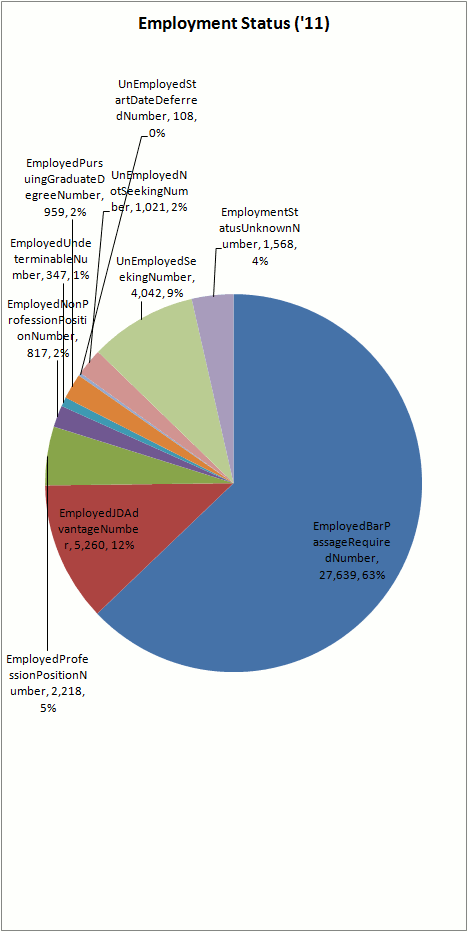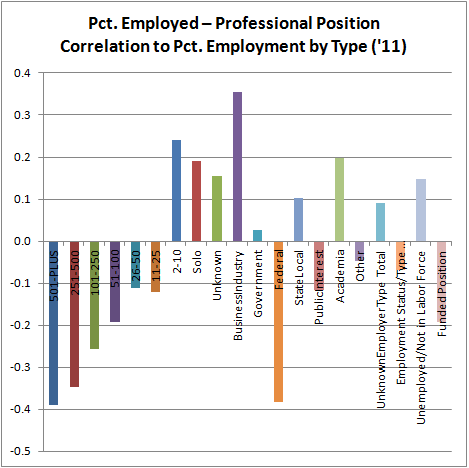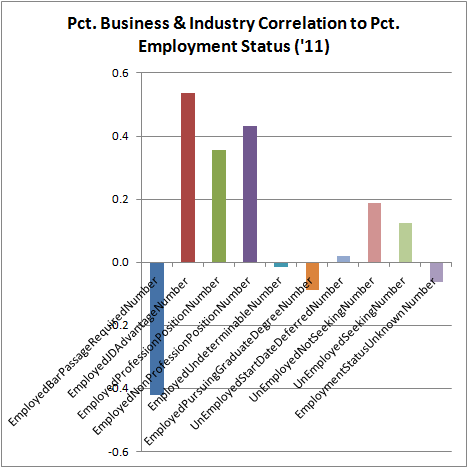On Sunday, July 29, 2012, minutes after his first career at bat, Brewers closer John Axford got one out in the top of the ninth, and with the score 9-7 in his favor he had a 96.4 percent chance of winning the game against the Nationals.
But the 3.6 percent won.
The Brewers lost in the bottom of the 11th, but the good news is that the extra innings gave me more time to reorganize the ABA’s data on the class of 2011’s employment outcomes to glean insights into the JD’s versatility.
I’m not sure I’ve seen it discussed elsewhere, but the new questionnaire creates what I see as four broad types of information:
(1) Total number of graduates (43,979) – This is our sacred denominator.
(2) Classification #1: Employment Status (43,979) – This is the upper section in the individual law school reports and tells us whether graduates are employed or if they bothered responding to the survey. It contains ten categories, the first five of which are employment categories, that is, graduates who are actually working for pay (volunteers are Unemployed – Not Seeking). These account for 36,281 graduates and are also broken down by full-time/part-time short-term/long-term (FT/PT-ST/LT) status.
(a) Employed – Bar Passage Required (27,639)
(b) Employed – JD Advantage (5,260)
(c) Employed – Professional Position (2,218)
(d) Employed – Non-Professional Position (817)
(e) Employed – Undeterminable (347)
(f) [Un]Employed – Pursuing Graduate Degree (959)
(g) Unemployed – Start Date Deferred (108)
(h) Unemployed – Not Seeking (1,021)
(i) Unemployed – Seeking (4,042)
(j) Employment Status Unknown (1,568)
(3) Classification #2: Employment by Type (36,273 graduates, plus eight graduates due to tabulation errors) – This is the breakdown of what occupations people in the first five employment status categories are in ((a)-(e) above). There are 17 categories also broken down by FT/PT-ST/LT.
(a) 501-Plus Law Firm (2,932)
(b) 251-500 Law Firm (880)
(c) 101-250 Law Firm (989)
(d) 51-100 Law Firm (887)
(e) 26-50 Law Firm (1,088)
(f) 11-25 Law Firm (1,888)
(g) 2-10 Law Firm (7,700)
(h) Solo Practitioner (1,170) – This is the only employment type that exclusively falls into the Employed – Bar Passage Required employment status
(i) Unknown Size Law Firm (449)
(j) Business & Industry (6,578)
(k) Government (4,324)
(l) Federal Judicial Clerkship (1,266)
(m) State/Local Judicial Clerkship (2,094)
(n) Public Interest (2,684)
(o) Academia (1,052)
(p) Other (34)
(q) Unknown Employer (258)
(r) Employment Status/Type Tabulation Error (8) – Three law schools (UC-Hastings, NYU, and SUNY Buffalo) lose a total of eight graduates from their Employment Status classification, which I attribute to an error on their parts.
(s) Unemployed/Not in Labor Force (7,698) – This is the sum of Employment Statuses (f)-(j), including those who didn’t reply to the survey.
(4) Classification #3: Law school-funded positions
(a) Law school-funded positions (1,973 graduates)
(b) Other Employed (34,308) – Simply everyone else
(c) Unemployed/Not in Labor Force (7,698) – This is the sum of Employment Statuses (f)-(j), including those who didn’t reply to the survey.
This means that Employment Status, Employment Type, and law school-funded positions are superimposed on one another like a 3-D Venn diagram. Allow me to animate an approximation:

The hard part was ensuring that all the numbers in the classifications’ categories added up to the total number of graduates. Many law schools include graduates in the total Employed Undeterminable employment status category but don’t break them down by FT/PT-ST/LT, creating a 261-graduate deficit if you sum the FT/PT-ST/LT breakdown. There’s also the tabulation error mentioned above.
Once this was complete (and the Brewers were futilely hitting home runs again), it was an easy matter to divide the Employment Status, Employment Type, and law school-funded classification categories by the total number of graduates and then run correlations between them to get where we want to go.
Why correlations? Because that’s the best way (short of something like chi-squaring and p-valuing them, which I don’t have time for) to find relationships between the three classifications for graduates’ outcomes.
Important #1: Pay attention to whether the correlation is between classifications or among categories in the same classification. The former means the correlation can be inclusive, e.g. graduates in Employed – Bar Passage Required can also be in 2-10 Law Firms if the correlation is positive. The latter means the correlation is exclusive, such as if the correlation between 2-10-Size Firms and Academia is positive, it means that the classmates of those who went to 2-10-Size Firms found jobs in Academia. Important #2: I also sometimes included the law school-funded classification in charts of Employment by Type correlations.
For example, we can find out what employment types law school-funded graduates (and their classmates) fell into. Behold:

From this chart we can make these kinds of statements:
“The more a law school’s graduates were in law school-funded positions, the more [they and their classmates were in Public Interest positions].”
As one might expect, there was a negative correlation between law school-funded employment and not being in the Unemployed/Not in Labor Force employment status. This is good. Any employment type or status that correlates positively with people out of work or not responding to the survey is bad for law schools and their graduates.
The important fact to take from law-school funded positions is that they might significantly weaken the meaning of the “Public Interest” and “Academia” employment types. This is the consequence of separating out law school-funded work from the other two classifications; it makes being a law professor’s post-graduate research assistant sound like a public service because law schools are mostly non-profit organizations.
If we want to know if the JD is versatile we have two employment statuses (Employed – JD Advantage, Employed – Professional Position) and one employment type (Business & Industry) that fit the bill. The problem is definitional, and you can find those in the ABA’s questionnaire (DOC). We find that the terms “Employed – JD Advantage,” (or “JD Preferred”) and “Employed – Professional Position” are undefined. “Business & Industry,” on the other hand, is defined:
Business and industry employers include legal temporary agencies, accounting firms, investment banking and financial institutions, entertainment/sports management companies, insurance companies, management consulting firms, publishing houses, technology/e-commerce companies, trade associations, political campaigns, etc. [LSTB: They don’t exclude everything else in the private sector, e.g. retail clerkery.]
Positions held in business and industry include temporary attorney work, temporary law clerk or paralegal work, in-house counsel, management, business development/sales/marketing, human resources, consulting, etc.
In-house counsel includes positions with the legal department of a company if that position reports directly or indirectly to the office of general counsel.
A graduate working at a law firm but employed by an agency that places attorneys in temporary positions is included in the Business and Industry category.
If the JD is versatile, then we would expect that businesses would compete with law firms for the top law schools’ top5%mootcourtlawreviewrequired, which would make the correlation positive between large law firms and federal clerkships with things like JD Advantage, Professional Position, and Business & Industry.
To test this hypothesis, the schools whose graduates have an employment status of Employed – JD Advantage, also have graduates who end up in the Business & Industry, Academia, and Government employment types.

I’m guessing there is significant mutual inclusion; however, it appears that law schools whose graduates are in JD Advantage positions tend not to send their classmates to larger law firms. Either government and business aren’t as interested in prestigious law school grads as large firms and judges are, or the opposite is true: law grads prioritize using their JDs in legal positions before government or academia. Looking at the data, the solution, I think, is that it’s regional: graduates from DC area law schools find their way into FTLT government positions nearby. This suggests a qualified versatility to law schools in that region, though this is only one graduating class and there will be no endorsement without a clear job description breakdown.
The same cannot be said for Professional Positions:

Remember what I said about correlating to the Unemployed/Not in Labor Force employment status? It would appear the term “professional” is unlikely to be what prospective students want to think it means and is associated with down-market legal work and underemployment.
Here’s how Business & Industry correlates to the other employment statuses, employment types, and law school-funded classifications:


The first chart tells us that graduates in Business & Industry don’t need law licenses (oo~h, big insight, LSTB) and that they split among JD Advantage, Employed Professional, and Employed Non-professional categories. This likely waters-down the definition of Business & Industry. The second correlation chart, on the other hand, is pretty damning. Correlating to small-firm work and underemployment suggests that Business & Industry is not very professional in any way we understand it.
Negatively correlating to law school-funded positions in particular really weakens the case for the versatile JD because it means that given the choice graduates would rather work at their law schools than positions in Business & Industry. Recall that law school-funded positions also correlated strongly to not being in the Unemployed/Not in Labor Force employment status.
The takeaway from this is:
(a) Capital region law schools with JD Advantage graduates might be able to make a claim to versatility if they back it up, e.g. FBI agents and people who could do the work without a law degree don’t count.
(b) Employed – Professional Position is a misleading employment term as those in that employment status and their classmates tend to be in down-market (and out-market) work.
(c) For most schools, Business & Industry mostly means non-professional work (which it always has). More prestigious law schools, ironically, are the ones that suffer from these blurred terms because if they do manage to place their graduates in versatile professional positions (like lobbying firms), their success is drowned out by graduates at other schools working at law firm temp agencies.
This is what happens when the Questionnaire Committee doesn’t rigorously define its terms.

Strong research and analysis of the situation, Matt. How many times does a non-legal employer really prefer a JD?
“(p) Other (34)”
One of those “others” must be Dean Conison’s “art gallery owners.”
http://www.huffingtonpost.com/jay-conison/law-school-_b_1653400.html